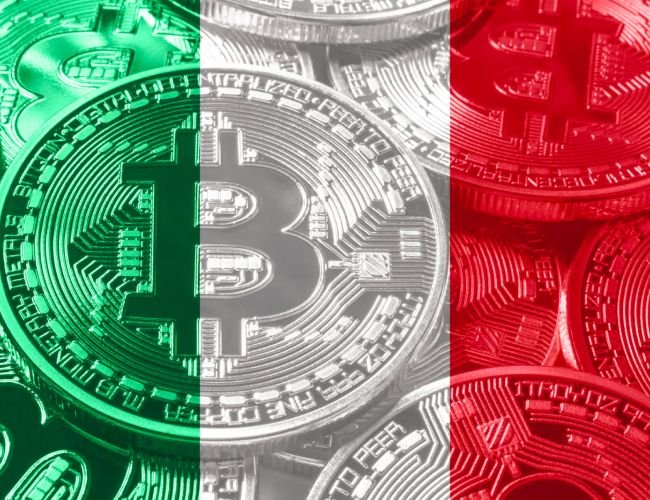Italy’s Deputy Finance Minister Maurizio Leo announced an ambitious plan to raise the capital gains tax on cryptocurrencies from the current 26% to a steep 42%. This significant tax adjustment was revealed during a conference that detailed Italy’s fiscal strategy for the upcoming 2025 budget. Positioned within a broader governmental effort to enhance revenue amid the escalating adoption of digital assets, this strategy marks a pivotal shift in Italy’s fiscal approach to cryptocurrencies.
Italian Government: “since the interest in cryptocurrencies is spreading, we are going to raise the capital gain tax on #Bitcoin to 43% (from 26%)”
What the hell I just witnessed. Moving tomorrow to another country. Outrageous. pic.twitter.com/0LxCprkGHF
— Arenx.eth | Binance Blockchain Week🇦🇪🔜 (@ArenxFinance) October 16, 2024
The proposed tax hike is part of a comprehensive €30 billion ($33 billion) budget for 2025 that aims to recalibrate various economic policies to boost national revenue. Included in the budget are critical modifications to Italy’s Digital Services Tax (DST), which notably remove the previous thresholds of 750 million euros in global revenue and 5.5 million euros from Italian digital services. This adjustment reflects a deliberate effort to capture more tax revenue from digital giants and the growing digital economy within the nation.
Addressing potential public concerns, Prime Minister Giorgia Meloni assured Italian citizens via social media that the new measures would not burden them with new taxes. She emphasized that the increased revenue from the capital gains tax would be specifically allocated to improving healthcare services and supporting vulnerable population segments. Deputy Finance Minister Leo also highlighted during the announcement that “the phenomenon is spreading,” acknowledging the rapid growth and integration of cryptocurrencies into the mainstream financial system as a substantial reason for the tax adjustment.
Financial Market Reactions and Economic Context
Contrary to expectations of a negative impact from the tax increase, the cryptocurrency market, particularly Bitcoin, has demonstrated remarkable resilience. Currently trading above $67,000, Bitcoin has shown a robust gain of more than 12% week-over-week. This level of trading vigor has not been observed since late July, signaling strong market confidence that could potentially mitigate concerns about the tax hike’s impact.
Despite the market’s robust response, there is apprehension within the investment community that the new tax rate could drive cryptocurrency investors to seek more favorable environments or move their operations offshore. Such shifts have been observed in other jurisdictions that have imposed aggressive taxations on cryptocurrencies. The prospect of Italy becoming one of the countries with the highest cryptocurrency tax rates globally adds to these concerns, posing potential challenges for local investors and the broader cryptocurrency ecosystem in Italy.
The tax revision arrives at a time when Italy is grappling with significant economic challenges, including an inflation rate that recently dipped below 1% in September. The government’s strategy to shore up revenues is critical in maintaining essential public services without imposing additional tax burdens on its citizens. The measures within the budget are projected to raise approximately €4 billion ($4.35 billion) by 2025, representing a modest but crucial 0.2% of Italy’s GDP.
Italy’s Approach to Crypto Regulation
In Italy, the allure of cryptocurrencies has captivated nearly 35% of families, indicating a significant public interest in digital assets. Despite this high engagement, Italy has taken a cautious approach to regulating crypto assets compared to its European counterparts. Instead of establishing specific domestic regulations, Italy has required crypto-related firms like exchanges and wallet services to register with the OAM Register primarily for anti-money laundering (AML) purposes. This move aligns with the broader European anticipation of the Markets in Crypto-Assets Regulation (MiCA), signaling a period of watchful waiting before committing to a comprehensive national framework.
The lack of specific regulations doesn’t imply a free-for-all atmosphere. Both the Bank of Italy and the Italian securities regulator, CONSOB, have frequently highlighted the risks associated with the volatile and opaque nature of cryptocurrencies. Their warnings underscore the potential dangers to the financial system and individual investors, emphasizing the still-evolving regulatory landscape’s precariousness.
From a data protection perspective, entities like crypto exchanges and wallet providers are deemed data controllers, bearing significant responsibilities under the EU General Data Protection Regulation (GDPR). They are mandated to implement robust security measures to safeguard customers’ private keys and personal data, reflecting the high stakes involved in managing digital assets.
The criminal implications of crypto misconduct are also notably stringent in Italy. Under the Criminal Code, illegal activities such as hacking for profit through unauthorized access to digital identities and data can lead to severe penalties, including imprisonment and fines. This legal framework aims to deter cybercrime and protect the integrity of digital asset transactions.
Regarding investment regulations, cryptocurrencies that meet specific criteria can be classified as financial products under the Testo Unico della Finanza (TUF), which encompasses a broader range of financial instruments. If a cryptocurrency offers financial returns and involves investment risks, it may require compliance with established financial regulations, including the filing of prospectuses with CONSOB and adhering to rules on public offerings.
Interestingly, the legal status of Non-Fungible Tokens (NFTs) and Contracts for Difference (CFDs) that involve crypto assets is still in flux. NFTs, which may represent ownership rights over digital or physical assets, could be treated as financial products if they promise financial returns and involve investment risks. The evolving interpretation of these digital assets under Italian law suggests a cautious approach to their integration into the financial system.
Furthermore, with the implementation of the EU’s AML 5 Directive, Italy has reinforced its AML requirements. Crypto service providers now face comprehensive obligations, including enhanced due diligence and mandatory registration. This ensures a tighter grip on the operational standards of crypto-related businesses, aiming to curb illicit activities such as money laundering and terrorism financing.
Lastly, the inclusion of a Fintech Sandbox Programme within the Growth Decree illustrates Italy’s commitment to fostering innovation while ensuring regulatory oversight. This program allows fintech projects to test and refine their offerings under a regulated yet flexible environment, indicating a supportive stance towards technological advancement in the financial sector.
Overall, Italy’s crypto asset regulation strategy reflects a balanced approach, accommodating the burgeoning interest in digital currencies while prioritizing consumer protection and financial stability. As the landscape evolves, Italy remains a keen observer, ready to adapt its regulatory framework in response to emerging challenges and opportunities in the crypto market.
Read the full article here










